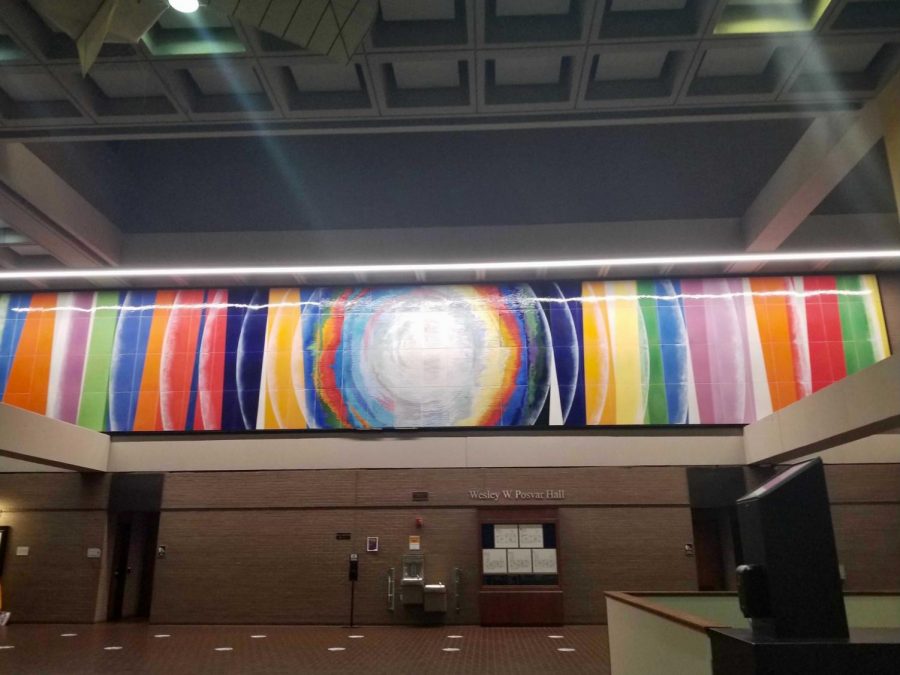Family, scholars of Virgil Cantini discuss late artist’s legacy
Charlie Taylor | Culture Editor
Artwork in Posvar Hall by Virgil Cantini, a Pittsburgh-based sculptor and founder of Pitt’s studio arts department.
November 20, 2020
Anyone who has studied in front of the brightly colored, geometric hanging rugs in Hillman Library, or taken the escalators past the massive mosaic in Posvar Hall, knows the “everyday” art of Virgil Cantini.
The Pittsburgh-based sculptor and founder of Pitt’s studio arts department made over a dozen public works of art on campus and throughout the City. Cantini was also the subject of “Art Every Day: Virgil Cantini,” a Zoom webinar on Wednesday night.
The roundtable discussion featured members of his family and two scholars of his work — Melissa Marinaro, director of the Italian American Program at the Heinz History Center, and Brittany Reilly, a member of Preservation Pittsburgh’s board of directors.
Lina Insana, an associate professor of Italian studies and the chair of the Italian Nationality Room, hosted the event alongside her student, Nick Giorgetti. A family friend of the Cantinis and president of the Italian Club, Giorgetti said he reached out to Insana after discussing Cantini in class, and the two began planning an event to bring his family in conversation with archivists and researchers.
“His name was mentioned, and I’m like, ‘I’ve heard that name a bunch of times,’” Giorgetti, a junior history and Italian studies major, said. “We tracked them down, and I sent a note and said, ‘Hey, your dad’s name came up in class. I think it would be cool if we could form an event.’”
Cantini’s daughter and grandson, Lisa Cantini Seguin and Andrew Seguin, opened the discussion by relating elements of the artist’s personal life, showing photographs from his childhood and his studio space as well as paintings he made while stationed in North Africa during World War II.
According to Cantini Seguin, her father lived in the small village of Pietransieri in central Italy until 1929, when his family moved to West Virginia in fear that their young sons would be conscripted into Mussolini’s army. Cantini Seguin described the adversity her father faced as an immigrant, including school counselors who discouraged him from applying to selective colleges despite his academic and athletic achievements.
“He was offered many college scholarships, both because of his grades and his football ability,” she said. “Even at that point, Yale University was interested in him, but the college counselor at his high school said, ‘You can’t go there. They’re all blue bloods, you’re an Italian immigrant.’”
Cantini enrolled instead in Manhattan College before transferring to Carnegie Mellon — then called the Carnegie Institute of Technology — after one year. In addition to studying art, he also played football on a scholarship, which Marinaro said surprised Pittsburgh sports journalists at the time.
“The journalists are surprised that someone with such athletic prowess can also be so artistic,” Marinaro said. “In Italy, we never would have questioned the masculinity or the athleticism of a fine artist.”
According to Marinaro, Cantini’s Italian background is also visible in his approach to art-making. In particular, she said Europe has a deep tradition of public art which spilled into his career even as an adult in America.
“Cantini, growing up in Italy, lived among public art as most Europeans do,” Marinaro said. “He always had the desire to create art that would be in public spaces, because he believed very strongly that art was not meant only for the museum.”
But Cantini’s work also drew from Pittsburgh’s industrial landscape. According to Marinaro, he used COR-TEN steel, produced by the Pittsburgh-based U.S. Steel Corporation, in his sculptures, and thought deeply about the connection between art and technology.
“You can see where he has fliers from different businesses talking about new materials,” Marinaro said. “He was looking at things we would have seen during the Renaissance… But then he’s also looking at COR-TEN steel, he’s looking at aluminum, he’s looking at newer materials and trying to figure out how he can apply those.”
Despite Cantini’s efforts to create lasting works of art, one of his public sculptures has come under threat in recent years. According to Reilly, the construction of a new public park in 2018 would have destroyed his mosaic in the pedestrian tunnel under Bigelow Boulevard Downtown.
Reilly, who currently leads an initiative to save the sculpture, said the City originally planned to reinstall just three of its 28 original panels. But thanks to her and her colleagues’ efforts, she said “the City of Pittsburgh is under contract to reinstall the entire mosaic in a new location.”
“[The new plan] is a far cry from the initial plan to save only a few of the panels,” Reilly said. “It’s really a testament to [the fact that] this work already contained power and energy, and kind of spoke for itself, but it was overlooked in the process of development.”
Although pedestrians in Pittsburgh may see public art like the mosaic tunnel every day without even knowing who Cantini was, the artist’s “everyday” work also expanded to more domestic, familial items. Seguin showed images of furniture in his apartment that his grandfather made, as well as ceramics, jewelry and metal sculptures on the Cantini family’s secluded property in Somerset County.
Marinaro said Cantini was adept with a wide range of media not always represented in his public art. According to her, his flexibility stands as another example of the influence of Italian traditions in his art, and his importance in Pittsburgh’s Italian American community.
“For us as Italian Americans, we really recognize that connection to Italy and I don’t know if people from outside the community can necessarily see that influence,” Marinaro said. “But as you get to know him, as you get to know his background, as you look at his work, it becomes clear that a lot of these ideas and traditions are coming from Italy.”



